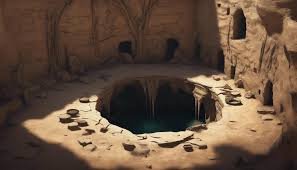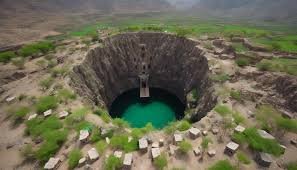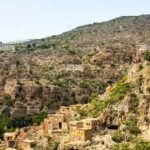In the remote Al-Mahra desert near Yemen’s border with Oman gapes one of Earth’s most terrifying natural wonders – the Barhout Well, a colossal sinkhole locals call “the Well of Hell.” This gaping void measures 30 meters across and plunges at least 112 meters deep (possibly far more), emitting foul odors and strange sounds that have inspired centuries of supernatural lore. Unlike ordinary sinkholes, Barhout possesses chilling characteristics that defy scientific explanation – objects dropped inside never make impact sounds, ropes lowered to measure depth mysteriously go slack, and local animals allegedly refuse to approach its rim. Ancient Arab geographers like Al-Hamdani wrote of this “gate to the underworld” in the 10th century, while modern geologists remain baffled by its perfect cylindrical shape and the unexplained cold winds that rush upward from its depths. The well’s sinister reputation is so powerful that even today, Bedouin tribes avoid camping within five kilometers of the site, whispering that it was created as a prison for rebellious djinn by King Solomon himself.
A Geological Anomaly Wrapped in Ancient Legends
The Barhout Well’s physical properties are as unsettling as its myths. Its walls consist of unnaturally smooth limestone devoid of the usual erosion patterns, appearing almost polished. The cavity maintains a constant temperature of 18°C despite surrounding desert heat, with periodic gusts emitting a sulfur-like stench locals call “the breath of Iblis” (Satan). Most disturbing are the acoustic properties – shouts into the well produce echoes that return seconds later, altered into unrecognizable reverberations. Yemeni geologists who studied the site in 2021 discovered the shaft narrows at 80 meters before expanding into a hidden chamber of unknown size, explaining why dropped objects never audibly land. Local legends speak of the well “swallowing” entire camel caravans during earthquakes, with 14th-century texts describing flashes of blue light emanating from its depths during lunar eclipses. Modern expeditions have detected brief electromagnetic pulses from the cavity that disrupt recording equipment, lending eerie credibility to ancient accounts.
Barhout Well The First Descent: Oman’s 2021 Expedition Breakthrough
For centuries, no one dared enter Barhout until October 2021, when an Omani cave exploration team made history by rappelling into the abyss. Their findings deepened the mystery. At 65 meters down, they discovered horizontal tunnels branching outward, their walls covered in strange, sponge-like mineral formations never before documented. The team’s LiDAR scans revealed the main shaft extends beyond 136 meters (contradicting earlier estimates) before curving horizontally into an uncharted cavern system. Most shockingly, their gas analyzers detected an unknown compound mixing with the sulfur dioxide – a volatile organic substance matching no known geological emission. Expedition leader Mohammed al-Kindi described “an overwhelming sense of being watched” throughout the descent, with helmet cameras malfunctioning precisely at the 112-meter mark. The team recovered unusual mineral samples now under study at Sultan Qaboos University, including a porous stone that emits faint static electricity when rubbed – a property local folklore attributes to “djinn stones.”
Supernatural Lore and Modern Encounters of Barhout Well
Barhout’s terrifying reputation permeates regional culture. Bedouin tradition holds that the well is one of several “prisons” where King Solomon bound disobedient djinn, with the muffled echoes representing their distorted pleas for release. Many locals recount seeing “black smoke figures” near the rim at dawn, while others tell of hearing metallic clanging from below during sandstorms. The most persistent modern account involves “the Well’s Keeper” – a shadowy figure allegedly photographed in 2018 by a French geologist, appearing to emerge from the shaft before vanishing. Yemeni military stationed nearby during the civil war reported radio interference and equipment failures when patrolling near the well, with one soldier’s sworn testimony describing a “column of darkness” rising from the hole at midnight. Even skeptical researchers admit to experiencing unexplained phenomena – watches stopping, sudden temperature drops, and an overwhelming urge to retreat that many attribute to subconscious detection of infrasound or toxic gases.

Scientific Explanations That Deepen the Mystery
Geologists propose Barhout formed through a rare combination of processes – ancient volcanic activity creating hollow lava tubes, subsequent limestone dissolution, and eventual roof collapse. However, this fails to explain several anomalies. The well’s perfect circularity suggests possible meteorite impact, yet no extraterrestrial material has been found. The cold updrafts could indicate a massive underground cavity, but seismic scans show only solid rock beyond 200 meters depth. Most puzzling are the 2021 expedition’s findings of “living rust” – iron oxide deposits that regenerate within weeks of being scraped off, a phenomenon previously documented only in deep ocean hydrothermal vents. Yemen’s Environment Protection Authority has detected fluctuating radiation levels near the well, with spikes coinciding with reports of “ghost lights.” The leading theory suggests Barhout taps into a previously unknown type of geological fault where subterranean chemical reactions produce both physical and perceptual anomalies, but conclusive evidence remains elusive.
Cultural Impact and Artistic Interpretations
The Well of Hell has inspired generations of Arabian artists and storytellers. Ancient rock art within 10km of the site depicts horned figures emerging from a circular pit, while medieval Islamic manuscripts describe Barhout as one of several “test places” where souls await Judgment Day. Modern Yemeni poets use the well as a metaphor for despair, and its likeness appears subtly in the architecture of Sayun’s mud skyscrapers as a protective symbol. In 2019, Saudi filmmaker Abdullah al-Eyaf created a viral short film based on legends of the well, with special effects artists consulting geologists to recreate its acoustics. Most intriguing are the well’s musical influences – traditional Mahri songs feature unusual 7/8 time signatures said to mimic the well’s echoes, while contemporary Omani metal bands use field recordings of Barhout’s winds in their compositions. This cultural adoption transforms a place of fear into one of creative inspiration, though few artists dare visit the actual site.
Visiting Barhout Well: Risks and Realities
Accessing the Well of Hell requires navigating Yemen’s ongoing conflict zones and securing rare permits from Al-Mahra authorities. The nearest village, Hima, lies 42km away, with no marked roads leading to the site. Those who attempt the journey must hire local Bedouin guides who follow strict protocols – no approaching after sunset, no loud noises near the rim, and absolute prohibition against throwing objects inside. Visitors describe an oppressive atmosphere even at distance, with the desert strangely devoid of wildlife near the well. The few journalists who’ve reached it report camera batteries draining inexplicably fast and audio recordings picking up subsonic rumbles. While no physical barrier prevents approach, an invisible perimeter seems to exist – nearly all visitors report an instinctive hesitation when coming within 20 meters of the edge, as if some primal warning system activates. Those who overcome this urge describe vertigo unlike ordinary height fear, with several accounts of people briefly seeing their own reflections distorted in the well’s darkness before snapping back to reality.
Why Barhout Well Captivates the Modern Imagination
In an age when Google Earth has mapped nearly every corner of our planet, Barhout Well remains stubbornly enigmatic. It represents the rare convergence of measurable scientific anomalies and enduring supernatural beliefs, where geology and folklore mutually validate each other. For researchers, it offers potential discoveries about extremophile life forms and unknown geological processes. For locals, it’s a sacred boundary between worlds, respected if not revered. The well’s greatest power may be as a psychological mirror – its perfect darkness reflecting back whatever fears or fascinations we project into it. As Yemeni poet Ali al-Muqri wrote: “Barhout is the eye through which the desert watches itself, reminding us that some mysteries must remain, lest we forget how to wonder.” Whether ultimately proven to be a unique geological formation or something more extraordinary, the Well of Hell ensures that even in our hyper-connected world, some places remain deliciously, terrifyingly unknowable.
The sinkhole stands as a natural monument to human curiosity’s limits – we can descend into its physical depths, but its full meaning remains just beyond our grasp. Perhaps this is why, after millennia of fear and speculation, no one has ever attempted to seal or fill Barhout Well. Some unconscious wisdom recognizes that civilization needs these dark mirrors, these bottomless questions that keep our sense of wonder alive. As climate change alters Yemen’s deserts and technology penetrates ever deeper into Earth’s secrets, the Well of Hell may yet have revelations to share – in its own time, on its own terms, whispering upward through cold winds that still carry the scent of the unknown.
Go to main page


